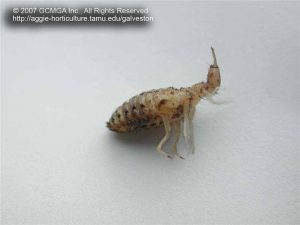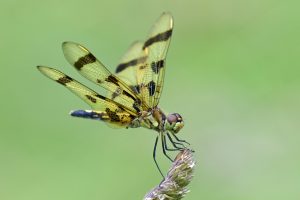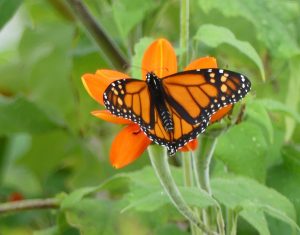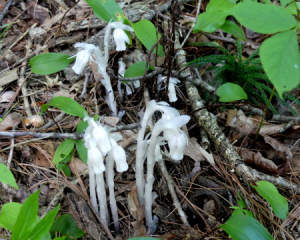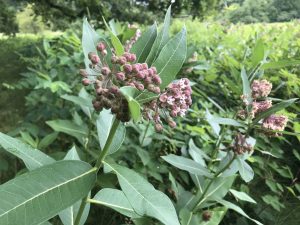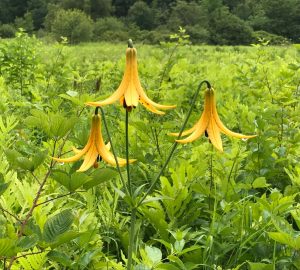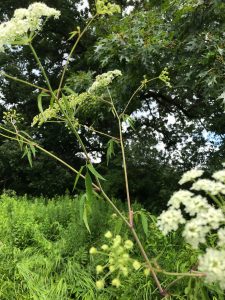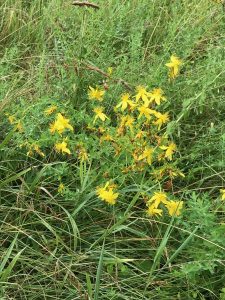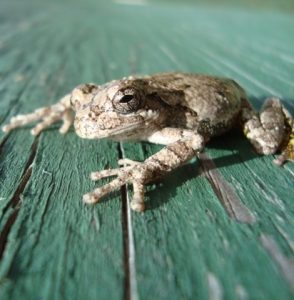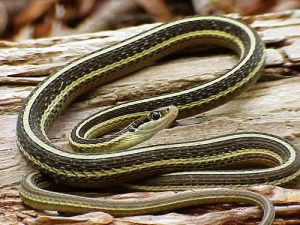Written by Gwyn Loud for the Lincoln Land Conservation Trust. She welcomes your sightings, questions, and photos at 781-259-8690 or gwynloud555 (at) gmail.com.
We are surrounded by the lush greenery of summer, the result of plenty of rain, sometimes in deluges and also in small showers. The last two weeks of June were wet and the first part of July has been mostly dry, very hot and humid, warmer than average. Higher temperatures have brought out the insects, including ones we like such as fireflies and butterflies, and less popular ones like mosquitoes, annoying small black flies, and earwigs. Honeybees nectaring on clover in the lawn are a welcome sight. Be sure to watch for dragonflies and damselflies, brightly colored and skimming over ponds and gardens. If you find a cluster of conical shaped depressions about an inch across in sandy protected places, such as under a barn overhang, you have found the traps of ant lions. The larval form of the ant lion hides in the sand at the bottom of the cone and waits for an insect such an ant to fall in and slide to the bottom, where it is devoured by the larva piercing, poisoning and paralyzing the prey, then sucking out the juices. A naturalist attracting night-flying insects to a light screen at Drumlin Farm for the BioBlitz (see below) wrote that on just one evening she had fifty species of moths and about thirty species of insects!
Over a twenty-four hour period on July 5-6 the Walden Woods Project, Minuteman National Park, EO Wilson Biodiversity Foundation, and Peter Alden, naturalist, sponsored the 2019 Great Walden BioBlitz. The goal was to discover as many species of flora and fauna as possible in a circle with a five-mile radius centered in Walden Pond. Many specialists as well as the public participated and preliminary results, documented on the app. iNaturalist, show over 4000 observations of more than 1000 species of plants and animals. Included was a plant never seen before in this area.
I am pleased to see that white pines are growing cones this year, as there have not been many recently. White pines are in trouble, however. As written in the latest Landscape Message from UMass Extension, “In recent years, white pines in the region have exhibited symptoms of decline, which include: yellowing/browning needles, premature needle shedding, thinning canopies, undersized shoots and needles, resinosis, branch dieback and death. Widespread health issues for white pine first developed in approximately 2009. In the ten years since these problems became apparent, a great deal has been learned and it’s now known that multiple fungal pathogens, an insect pest and a changing climate are responsible.” For more information go to https://ag.umass.edu/landscape/fact-sheets/dieback-of-eastern-white-pine
Catalpa trees, such as the “twisted tree” by the Library have had showy white clusters of flowers and mulberry trees have ripening fruit, attracting squirrels, chipmunks (yes they climb!), and all sorts of birds such as robins, Baltimore orioles, and blue jays. Both poison ivy (native) and bittersweet (invasive) are flourishing, more evident than ever. In fields milkweed is blooming and hopefully will attract monarch butterflies. Naturalist Mary Holland writes, “Female Monarch Butterflies lay 300-500 eggs over two to five weeks of egg-laying. Normally, a Monarch only lays one egg at a time (on the underside of a tender, young milkweed leaf). It is fairly rare to find more than one egg on a leaf, or even on the same plant.” Other field flowers include daisy fleabane, red and white clover, cow vetch, bouncing bet, and common St. John’s-wort. On a recent walk in Browning Field North I came across the towering water-hemlock, spotted Joe-Pye-weed in flower, and beautiful Canada lilies. In the woods watch for waxy white Indian pipes, a parasitic plant with short stubby roots which contain fungi. Quoting from the Botanical Society of America, “ The fungi extend in a web-like way through dead rotting leaves and connect up to the roots of conifers. The conifers provide sugar, which the fungi carry to the Indian Pipe plant.” Waterlilies both pink and white, add beauty to ponds.
Birds are quieter now, busy with second broods and caring for new fledglings. Observers have reported nesting birds such as screech owls, indigo buntings, Eastern bluebirds, and probable breeding Virginia rails, as well as all our common birds. The warblers nesting in Lincoln include the yellow, pine, and common yellowthroat. At Drumlin Farm eleven killdeer chicks were spotted recently in the crops fields and so far thirty-six tree swallows have fledged in the boxes there. My feeders are mobbed with families of downy woodpeckers, tufted titmice, house finches, white-breasted nuthatches, and cardinals, as well as the gorgeous male rose-breasted grosbeak, which visits sporadically. Some birds continue to sing all summer; a mockingbird, which mimics the songs of other birds, was heard singing the songs of a mallard, killdeer, Carolina wren and Eastern phoebe. What a repertoire! I have been happy to hear a few wood thrushes singing during the day and evening, one even on a hot July 4 in the woods south of Pierce House.
Frogs, turtles, and snakes (mostly garter snakes) are very evident, though often as road kills, alas. This is the time to find thousands of green frog and bullfrog tadpoles, and if you want to hear green frogs giving their banjo-like “glunk” calls, stop by the two ponds next to Pierce House. I was surprised to find a tiny gray tree frog clinging to the outside of an upstairs screen one evening.
Among the mammals reported are many rabbits; I was not happy to find Mr. Peter Rabbit inside my vegetable garden, looking guilty (or triumphant?) after eating a row of beets. Coyotes seem more numerous; if you check out this recording
you can hear one I recorded on a recent evening near the house. An observer watched a beaver which had piled sticks near a spillway below the former Harrington house along Stony Brook South and she also reported seeing several pairs of does and fawns, including a newborn fawn no larger than a cat.
August brings the Perseid meteor showers, always a good show as the Earth moves through the tail of debris left from ancient comets. The Perseids will peak after midnight on August 11, 12, and 13, but it is worth looking for these “shooting stars” both before and after those dates.
My column will resume in September. In the meantime, enjoy the bounty and beauty of wildlife during the rest of the summer and please send in your sightings.
© Gwyn Loud


